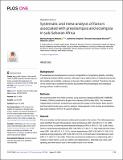| dc.description.abstract | Background
Preeclampsia and eclampsia are common complications of pregnancy globally, including sub-Saharan African (SSA) countries. Although it has a high burden on maternal and neonatal mortality and morbidity, evidence on the risk of the problem is limited. Therefore, the aim of this review was to examine the factors associated with preeclampsia and eclampsia among mothers in SSA countries.
Methods
We searched article from SSA countries using electronic database MEDLINE, EMBASE, PubMed, CINAHL published in English from January 2000 to May 2020. Two reviewers independently screened, extracted and assessed the quality of the articles. Both random and fixed effect model were used for analysis. Heterogeneity of the studies and publication bias were checked. STATA 16 used for analysis.
Results
Fifty-one studies met the inclusion criteria and included in this review. The following factors were identified through meta-analysis: being primiparous (OR: 2.52; 95% CI:1.19, 3.86), previous history of maternal preeclampsia/eclampsia (OR:5.6; 95% CI:1.82, 9.28), family history of preeclampsia/eclampsia (OR:1.68; 95% CI:1.26, 2.11), high maternal body mass index (OR: 1.69; 95% CI:1.17, 2.21), chronic hypertension (OR: 2.52; 95% CI:1.29, 3.74), anaemia during pregnancy (OR: 3.22; 95% CI:2.70, 3.75) and lack of antenatal care visits (OR: 2.71; 95% CI:1.45, 3.96). There was inconclusive evidence for a relationship with a number of other factors, such as nutrition and related factors, antenatal care visits, birth spacing, and other factors due to few studies found in our review.
Conclusions
The risk of preeclampsia and eclampsia is worse among women who have a history of preeclampsia/eclampsia (either themselves or family members), primiparous, obesity and overweight, living with chronic disease, having anaemia during pregnancy and absence from ANC visits. Therefore, investment must be made in women’s health needs to reduce the problem and health service providers need to give due attention to high-risk women. | en_US |

